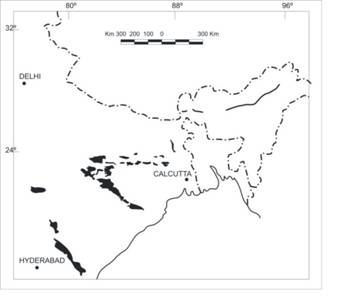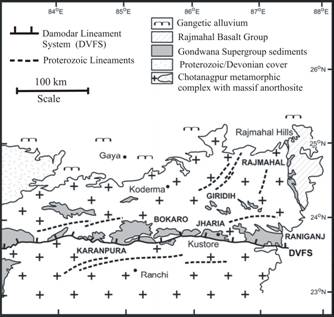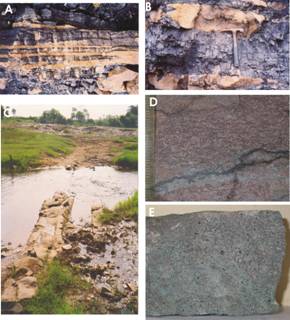|
FIELD INTINERARY FOR EASTERN INDIA GONDWANA COALFIEDS' LAMPROITES LIKE ROCKS
(Offered Post: Conference)
Team Leaders: Sambhu Chakraborty, Ashok Kumar Bhattacharya, Manoj Maitra and Subrata Sardar.
Dates: Post Conference – Sunday 12th February 2012 to Friday 17th February 2012.
Field Trip Cost : 75,000 INR (1250 €): The cost includes (i) air travel between Bangalore and Ranchi, (ii) air travel between Kolkata and Bangalore (iii) transport from airport to hotel, (iv) road transport between Ranchi and Dhanbad; (v) road transport between Dhanbad and Kolkata (vi) local transport from hotels to lamproite and other field locations, (vii) transport to sites of tourist interest (viii) breakfast, pack lunch and dinners for five days (ix) Pick-ups and transpor to air ports, and (x) six night‘s hotel accommodation at Dhanbad and Ranchi (please see the details below).
Please note the following:
•Those delegates who do not wish to return to Bangalore and have their separate return journey from Kolkata may write to the Secretariat in a separate email. The cost of return air fare will be reimbursed at Bangalore during the Conference.
•The field trips are financially self supported, would be conducted on no profit and no loss basis. If field trip finishes with a significant surplus refunds will be made to the delegates
Number of Participants: The maximum number of participants on post-conference field trips is 30. A minimum number of 20participants would be required to run each of the field trips.
General Description: The coal bearing Gondwana and associated rock groups of the Eastern Indian coalfields are long known to have been intruded by innumerable dykes of dolerite and dykes and sills of alkali-ultramafic compositions. The latter is presumed to form a consanguineous suite of a spectrum of rock types (minettes, monchiquite, lamproites, mica-peridotites and microsyenites) that is known in contemporary literature as to represent rock species of contrasting petrogenetic affinities.This rock association has come to be known as unique one because the alkaline-ultramafic rocks here show kinship not only with the associated rocks that occur far apart in space but also reported to display evidences of differentiation in a single lamprophyric intrusions of a few meter width. The presence of these dykes was known from the earliest period of coal mining activity in the region (mid-eighteenth century). The damaging contact metasomatic effect (development of
natural coke along the contact zone to the extent as high as five times of the width of the intrusions) that these intrusionscause on the coal seam was the most worrisome matter for the miners.
Regional Geology: The Eastern Indian Coalfields, occurring amidst Archaean metamorphites of Chotanagpur Gneissic Complex towards the northern fringe of the Singhbhum craton, define an arcuate pattern (Fig. 1) and are distributed mainly in the states of West Bengal, Jharkhand and Bihar. The economic coal bearing horizons occur in three distinctstratigraphic units of the Lower Gondwana formations. These are – Karharbari (Early Permian), Barakar (Early Permian) and Raniganj (Late Permian). The Barakar and Raniganj formations are separated by a thick non-coal bearing formation

Fig-1

Fig-2
referred to as Barren Measures. The Karharbari, the lower most coal-bearing member of the Gondwana, have restricted development in different basins with a maximum thickness of 300m. The Barakar Formation, varying in thickness from less then 300m to over 1000 m is the storehouse of coal in almost all the Indian Gondwana coalfields. Raniganj Formation assumes importance in the two eastern coalfields of Damodar Valley basin i.e Raniganj and Jharia. The coal reserves in these basins are far surpassing then that of the Barakar. The coal-bearing Gondwana sediments occur in the disconnected basins along the east-west trending Damodar Valley and are referred as per the locality names (Fig.2). These basins from east to west are Raniganj, Jharia, Bokaro and Ramgarh. An isolated basin of Giridih occurs towards the north of Raniganj and Jharia basins. Each of these basins is thought to have been developed as a consequence of E-W trending extensional faulting in the Precambrian basement. A major lineament (Damodar Lineament System – DVFS; Figure 5.2) apparently connects the disconnected basins. The mode of occurrence of these intrusives in all the individual sub-basins of Damodar Valley is remarkably alike. In Raniganj collieries these occur as lenticular sill or small lenticles with connecting necks (Fig-3 B); small braches and thin ramifications, tongues, apophyses, splitted and anastomosed (Fig.3 A) and fairly large dykes (Fig. 3D).
.

Fig.3
Petrography: The petrological work on these lamprophyres was initiated during the later part of the nineteenth century. Rutley of royal College of Science, London made the first microscopic examination of these rocks in 1880 and subsequently by Holland, P.N.Bose and Chatterjee and classified them as mica-trap or mica-peridotites. Fermer in 1916, described certain types from Bokaro as apatite minette and mica-peridotite. Auden and Banerjee in 1932 concluded that a variety of rock types occur in lamprophyres of the coalfield and may of these show consanguinity. Rock and Paul in 1988 have pointed out that some names are particularly confusing. They opined that the so-called "leucite-microsyenites", are actually basic-ultrabasic (DI~40%) and mildly to strongly silica-over saturated, although petrographic descriptions of other "microsyenites" appear unexceptionable. Furthermore, the terms "mica-peridotite", "lamprophyre" and "mica-lamprophyre" are used virtually interchangeably in many papers, and these authors therefore consider them together. According to Rock and Paul the "mica-peridotites"are apparently variable rocks, comprising phlogopite, olivine pseudomorphs with phlogopite reaction rims, magnetite, apatite, anhedral diopside and occasional amphibole. Middlemost and co-workers studied samples from north of Kulti and west of Barakar in the Barakar Formation within the Raniganj coalfields and identified a minette-lamproite association comprising of four rock types namely minette (20% K-feldspar and titan-phlogopite), olivine minette (feldspar, titan-phlogopite and about 6% olivine), titan-phlogopite lamproite (titanphlogopite, analcime, potassium feldspar, ferroan-magnesite, priderite and talc) and spessartite. Kent and co-workers in 1997 discussed the coalfield intrusives under a common head of Damodar Alkaline Igneous Rocks (DA1R) and suggested that these rocks are comparable with the Group-II kimberlites (orangeites) of South Africa. Srivastava and co-workers in 2009 interpreted potassic ultramafic rocks of Jharia area as similar to ailikites. Mitchell and Kent in 2010 studied samples from Jharia and Raniganj areas and conclude that the hollandite group mineral assemblage in these rocks is similar to that found in South African orangeites and typical lamproites from Wyoming and Australia. Mineralogical studies of Raniganj samples by Mitchell and Fareeduddin in 2010 suggest that (i) although these rocks have many of the mineralogical characteristics of lamproites (sensu lato), they are sufficiently different such that they must be recognized as the local expression of potassic magmatism in the northern Singhbhum craton. Following Mitchell (2006, 2007), they are best described as lamproites (var. Damodar) and (ii) this magma is undoubtedly derived by the partial melting of ancient, mineralogically complex, veins in the lithospheric mantle comprising the northern Singhbhum craton.
Mitchell in 2007 reviewed the nomenclature confusion that prevails in classifying the coalfield potassic intrusive rocks and alluded the unsatisfactory situation to several factors. In order to avoid the proliferation of local names for the variety of potassic rocks, the simplest solution Mitchell suggests is to designate all rocks derived from MLM-mamga types as “lamproite sensu lato”. This would broaden the existing definition of lamproite and result in abandonment of the name “orangeite”. Further, should one wish to emphasize the unique characteristic of lamproite-like potassic rocks in a particular geological setting, a modifier could be attached to the stem name, e.g olivine-phlogopite sanidine lamproite (var. Damodar), phlogopite sandine lamproite (var. Wyoming), phlogopite lamproite (var. Kaapvaal). Further, Mitchell (ibid) calls for detailed geological, mineralogical and geochemical studies be undertaken by the Indian geoscience community, as a Pan-Indian project, on the complete range of rock types found in the Gondwana coalfields differentiated sills and dikes. Such work would supplant the previous piece-meal investigations of the character of this potassic magmatism. Comparison with the Mainpur area rocks will also lead to a better understanding of the evolution of the Singhbhum craton.
Some Useful Comments: Some other points pertinent to this field are:
-
February is a spring time. The weather is mildly warm to the maximum of 30 degrees celsius during the day, however the nights could be nippy and down to about 10 degrees celsius as the minimum. The average temperature is even moderate between 25 and 15 degrees celsius. Rainfall is rare.
-
Accommodations at Dhanbad, Kulti and Kolkata will be in shared hotels rooms.
-
Cuisine in most places is likely to be Indian, which could mildly spicy. The Hotels would provide multi-cuisine food, including continental.
-
Safe bottled water is recommended for drinking and would be arranged.
-
Adequate government security would be arranged for participants who stick to the IKC field group.
-
Malaria and other mosquito borne diseases are rare in this region in the month of February, however, it would be advisable to consult your respective nation consulates or WHO sites on any health warnings.
-
Field Trip Guide books will be posted in the website and printed copies with maps would be made available to all the participants.
-
Sampling at all the localities are possible. The participants who wish to collect samples, are (i) invited to bring their preferred sampling equipments (ii) sample packing material and (iii) should be prepared to cover the cost of sample shipment.
-
Travel from Bangalore to Ranchi and return journey from Kolkata to Bangalore would by flights and road journeys from Ranchi to Kolkata by delus coaches. Road transport from hotels to the different localities of lamproites would by field vehicles.
-
There is no specific dress code for the field trip. But in view of local weather conditions light trousers and long-sleeved shirts are recommended.
-
Participants must arrange for their own travel and medical insurance.
The route map for the field trips can be viewed with the below link
Field Trip day to day itinerary
12-02-2012
0600 Hrs |
Leave Bangalore and Arrive at Ranchi airport..
Departure Ranchi Airport, Arrival Kuju. Study of lamproites of West Bokaro Coalfields. Departure Kuju, Arrival Dhanbad. Halt at Dhanbad. |
13-02-2012
0800 Hrs |
Departure Departure Dhanbad, Arrival Chandrapure
Study of East Bokaro Coalfields.
Return to Dhanbad and Halt. |
14-02-2012
0800 Hs |
Visit to Jharia Coalfield and study of lamproites. |
15-02-2012
0900 Hrs |
Departure Dhanbad. Arrival Kulti.
Study of lamproites of Raniganj Coalfields
Halt at Kulti/Barakar |
16-02-2012
0800 Hrs |
Departure Kulti/Barakar. Arrival Jamliad.
Study of lamproites of Jamliad Opencast Project.
Arrival – Kolkata. Halt |
17-02-2012 |
Departure Kolkata. Arrival Bangalore. |
Field Trip Deadlines:
|
|
| 1. Field Trip Registration Opens |
1st February 2011 |
| 2. Field Trip Registration Closes |
1st September 2011 |
| 3. Field Trip Cancellation Less 5% Closes |
30th September 2011 |
| 4. Field Trip Notification |
1st October 2011 |
| 5. Field Trip Cancellation Less 50% Closes |
1st December-2011 |
Registration & Refund guidelines for the Field Trip:
Registration guidelines for the field trips are as follows:
-
Only those persons are entitled for registration to the field trips who have registered for the main conference.
-
Registration for the field trips requires full payment of appropriate fee.
-
Field Trip Refunds: Refunds resulting from cancellation by a delegate are less 10% administration fee before 30th September, 2011. Between 1st October 2011 and 1st December 2011 refunds will be 50% of the total field trip costs. There will be no refunds after 1st December, 2011.
-
If field trips are cancelled by 10 IKC through insufficient participation prior to 1st December 2011, field trip payments will be refunded in full.
-
If delegates are not allocated a place on any of the requested field trips, an option for the other field trip, if available, would be made available to the participants on the condition of payment/return of the differential fee of that field trip. In case the delegate is not interested in that option, the field trip payments will be refunded in full.
-
All requests for cancellations of field trip participation must be received in writing by post, e-mail or fax by the Conference Secretariat. Cancellations are not accepted by telephone. All cancellations are subject to the limitations specified above.
|